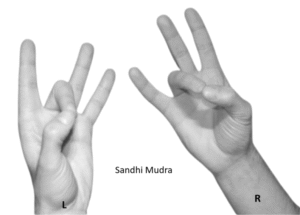Sandhi Mudra (Joint Pain relief)
Introduction
Mudras are symbolic hand gestures in yoga that influence the flow of prana (vital energy) and affect physical, mental, and spiritual well-being. Sandhi Mudra is specifically used to strengthen joints, improve flexibility, and maintain structural integrity of bones and connective tissues.
The term “Sandhi” in Sanskrit means “joint” or “connection,” reflecting this mudra’s focus on preserving joint health, alleviating stiffness, and enhancing circulation in hands and fingers. It is often practiced alongside other mudras, meditation, or yoga routines targeting musculoskeletal health.
Meaning
Sandhi = Joint, connection, articulation.
Mudra = Yogic seal or gesture.
Purpose: To support joint health, flexibility, and the smooth flow of energy through connective tissues.
How to Perform (Practice)
Sit comfortably in a meditation posture such as Sukhasana, Padmasana, or Vajrasana.
Relax shoulders, spine, and arms.
Right Hand: Join tips of Ring Finger and Thumb together.
Left Hand: Join tips of Middle Finger and Thumb together.
Place the palms, face-up, on your knees or thighs. Keep your spine and head straight, shoulders relaxed.
Close your eyes and focus on energy flowing through the joints and fingers, promoting flexibility and health.
Maintain the mudra for 5–15 minutes, gradually increasing as comfort improves.
Tip: Keep hands relaxed; avoid straining fingers or wrists.
Benefits
Physical Benefits
Strengthens joints, ligaments, and connective tissues.
Improves flexibility in fingers, hands, and wrists.
Enhances circulation and pranic flow to joints.
Helps reduce stiffness and prevent degenerative joint conditions.
Mental & Emotional Benefits
Promotes calmness and focus.
Reduces stress associated with physical discomfort or stiffness.
Enhances mind-body connection and awareness of physical alignment.
Spiritual Benefits
Supports meditation by stabilizing hand posture and prana flow.
Enhances energetic integrity of the body, allowing deeper focus and spiritual awareness.
Facilitates subtle energy circulation in relation to structural alignment.
Contraindications
Finger, hand, wrist, or shoulder injuries.
Severe arthritis or joint inflammation should practice under guidance.
Avoid over-practice if discomfort occurs.
Anatomy & Physiology
Musculoskeletal: Activates intrinsic hand muscles, stabilizes fingers, and engages wrist and forearm muscles.
Circulatory system: Improves blood flow to fingers, hands, and upper limbs.
Nervous system: Stimulates sensory nerves, promoting awareness and motor coordination.
Connective tissue health: Supports joint lubrication, tendon flexibility, and ligament strength.
Kinesiology
Fingers interlocked and thumbs extended to form a stable seal, directing energy through joints.
Maintains neutral wrist alignment to avoid strain.
Shoulders relaxed; forearms lightly engaged.
Enhances proprioception, hand stability, and subtle energy flow through joints.
Neurology
Stimulates sensory nerve endings in fingers and palms, improving fine motor control and hand awareness.
Promotes parasympathetic activity, aiding relaxation of joint-associated muscles.
Supports cortical regions related to motor planning, tactile feedback, and proprioception.
Enhances subtle energy awareness in relation to skeletal structure.
Duration of Mudra
Beginners: 5 minutes.
Intermediate: 10–15 minutes.
Advanced: 20–30 minutes during meditation or yoga practice.
Tip: Regular practice improves joint health, flexibility, and energy circulation.
Counter Mudra
Prana Mudra: To energize the body after joint-focused practice.
Apana Mudra: To release stagnant energy from limbs.
Gyan Mudra: To combine mental clarity with joint stability.
Conclusion
Sandhi Mudra is a mudra that strengthens joints, enhances flexibility, and supports musculoskeletal and energetic health. Regular practice provides physical, mental, and energetic benefits, making it ideal for meditation, yoga, and daily hand and joint wellness routines.
FAQ
Q1. Can beginners practice this mudra?
Yes, it is simple and safe for all levels.
Q2. Can it help with joint stiffness or mild arthritis?
Yes, it improves flexibility and circulation in fingers and hands.
Q3. How long should it be practiced daily?
5–15 minutes for beginners; up to 30 minutes for advanced practitioners.
Q4. Can it be combined with pranayama or meditation?
Yes, it enhances meditation and energy circulation while maintaining joint stability.
References
Swami Satyananda Saraswati, Asana, Pranayama, Mudra, Bandha.
B.K.S. Iyengar, Light on Yoga.
Hatha Yoga Pradipika – Mudras for joint health and energy flow.
Gheranda Samhita – Mudras for musculoskeletal and energetic wellness.
Kuvalayananda, Yoga Mimamsa Journal.

